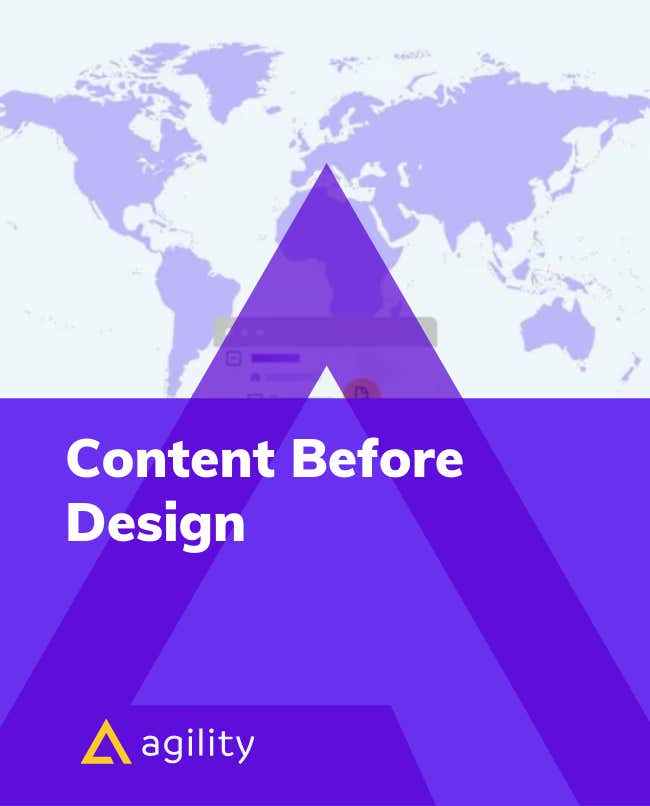Content Before Design
How To Start Using The Content-First Strategy

Technology changes fast. That's why companies and brands need the tools to provide useful, accessible content across all digital channels and at every stage of the customer journey.
Savvy marketers are migrating from a website-first strategy to an omnichannel approach that places content at the front and center of your company initiatives.
A content-first approach can help you to deliver the right content, in the right place, at the right time.
Focusing on content before design enables marketing teams to create, publish, and distribute to every device faster.
What Is Content-First Strategy?
In a content-first strategy, content is part of the design process. Content serves as a way to map user journeys and create a product story before proceeding with creating the website.
The content-first approach looks at the big picture of what the marketing team is trying to accomplish and then uses the appropriate language to build a beautiful, functional website or app.
The content-first approach emphasizes collaboration and focuses on building a logic structure of how the content will be presented. It enables marketing and development teams to create a comprehensive full-picture website that takes the context, the problem, and the user into account.
Headless CMS and Content-First
Let's not forget that a headless CMS is a tool, not a strategy. A headless CMS connects the content with the user and serves as a bridge for an outstanding experience.
In a nutshell, here is what it means to be content-first with the help of your CMS:
- Website or app front-ends can be rewritten easily without changing the content in your CMS.
- Less time spent rebuilding a website.
- By starting with content, marketing teams can create content definitions and relations that stand the test of time.
- Content serves as a single source of truth.
- Content that is explicitly designed for a website, app, line of business, or organizational segment, can be placed in a property instance.
The Five Pillars of a Content First Strategy
1 | Organization and Management. Before thinking about design, you need to establish all the essential elements of your content and what you want to accomplish with your website.
2 | Output and Design. Now that you have your content organized, it's time to think about how to transform that content into something visually appealing for the user.
3 | Content Strategy. Having clear goals about what your content should do and the infrastructure that supports it is fundamental to deploying a content-first strategy.
Your technology stack is the technology that's going to help you succeed, and its central part is your CMS.
4 | Technology. A headless CMS supports the strategy and the architecture of your website. It provides you with the tools you need to organize and build your websites and apps.
5| Continuous improvement. Your web presence needs to be nurtured, so it grows and scales exponentially.
The Steps of a Content-First Strategy
1 | Separate Content From Presentation
Separation of content and presentation is a design principle where visual and design aspects are kept separate from the material and structure. This means that the content should only contain semantic markup.
It simplifies presentational changes, from a slight design adjustment to a full-fledged redesign as all content is free of presentation and works with any template.
2 | Organize Content For Easy Management
Defining the structure of the content and types of available content can have significant benefits for digital teams and stakeholders at any phase of your development process. This structure of content is also known as the content model and helps you manage every piece of content quickly and efficiently.
3 | Evolve Before Revolutionize
The content-first strategy aims at building a website you don't have to rebuild again and again. That's why content-first focuses on the structure and content instead of the design because with content you can always tweak things and evolve existing assets without having to rebuild a website from scratch.
Drawbacks of The Design-First Approach
1 | Sloppier Builds
If you start with the design, you start with a constraint. In a design-first strategy, marketing teams focus on building a wireframe and then think of the content. This results in sloppier builds that don't consider the user intent.
2 | Websites Get Slower Over Time
When you're building a website from the design perspective, you usually end up adding functionalities and more plugins and integrations. This not only results in a slower, clunky website, but it also impacts the development time and your bottom line.
3 | Updates Become Scary
Some CMSs aren't really update-friendly, and marketing teams end up dreading having to update because of the possibility of an update bringing the whole website down and not being able to update results in websites becoming a monolith, severely limiting your ability to deliver meaningful experiences.
How To Start Using The Content-First Strategy
Think of Your Content Architecture
Starting with your content architecture makes sure that you answer all the questions about your content and what kind of content is important to your organization.
When it comes to designing your content architecture, you need to include your content, your team, and your integrations.
Create a Technical Architecture
Establishing a technical architecture helps you assess how well-optimized your tech stack is for each of the channels where you intend to present your content and devise strategies on how to optimize it.
Your technical architecture includes templates, modules, and development frameworks.
Categories
eBookseBooks
Topics
Content ArchitectureContent Architecture
Need help with Content-First Architecture?
We are here to help!
